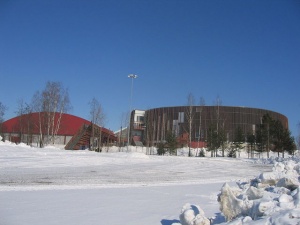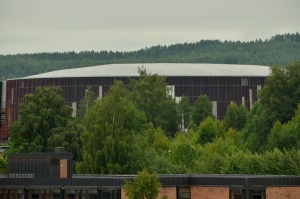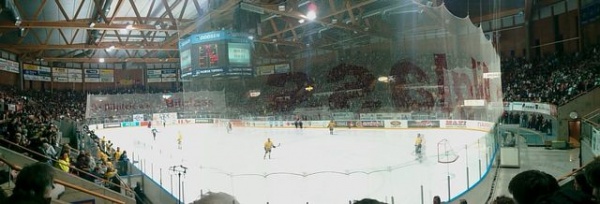CC Amfi
| CC Amfi | |
|---|---|
| Fjøset ("The Barn") | |
 CC Amfi (right) and Storhamar Ishall | |
| Full name | Nordlyshallen |
| Location | Storhamar, Hamar, Norway |
| Opened | 25 November 1992 |
| Owner | Hamar Municipality |
| Operator | Hamar Olympiske Anlegg |
| Construction cost | NOK 83 million |
| Architect | HRTB |
| Former names | Hamar Olympic Amphitheatre (1992-2015) |
| Tenants | Storhamar Dragons (1992-present) |
| Capacity | 7,000 |
CC Amfi, also known as Nordlyshallen ("The Northern Light Hall") is an indoor sports arena in Hamar, Norway. It is mostly used for ice hockey, but is also used for short track speed skating, figure skating, handball, events and concerts. The venue has a capacity for 7,000 spectators and was built for the 1994 Winter Olympics, where it was used for short track speed skating and figure skating. Other major events held at the arena include the 1999 IIHF World Championship in ice hockey, the 1999 World Women's Handball Championship, the 2012 IPC Ice Sledge Hockey World Championships and the 2016 Winter Youth Olympics.
Construction of CC Amfi started in August 1991 and it was inaugurated on 25 November 1992, with construction costing 83 million Norwegian krone (NOK). The venues are owned by Hamar Olympiske Anlegg, a subsidiary of Hamar Municipality.
History
The Olympic venue
In the unsuccessful Lillehammer bid for the 1992 Winter Olympics, ice hockey events were proposed played in Hamar and Gjøvik. However, in the Lillehammer bid for the 1994 Winter Olympics, all ice events were moved to Lillehammer proper,[1] after recommendations from the International Ice Hockey Federation, who wanted all the ice hockey events to take place in the same town. This would involve building two temporary ice rinks at Stampesletta in Lillehammer, and after the Olympics moving them to Gjøvik and either Moelv, Brumunddal or Kongsvinger. By 1989, the International Olympic Committee (IOC) decided to include short-track speed skating, increasing the number of ice halls from two to three. In April, the Lillehammer Olympic Organizing Committee (LOOC) therefore proposed building permanent ice rinks in Hamar and Gjøvik.[2]
The IOC also required that the long-track speed skating be done indoors. Hamar was awarded the venue, Vikingskipet, after Hamar Municipality guaranteed to cover all costs exceeding NOK 200 million. This provided sufficient leverage for Hamar to host additional events.[1] LOOC approved the construction of Vikingskipet in on 15 December 1989 and at the same time supported proposals to renovate Storhamar Ishall to host Olympic ice hockey matches. A second, temporary training rink was also planned built in Hamar.[3][4] In addition, the Hamar venue would be used for short track speed skating, while figure skating would be run in Lillehammer.[5] In March, the plans were changed, so Hamar would receive an all-new ice rink in addition to a renovation of Storhamar Ishall.[6]
Financing of the venue was officially granted by the Parliament of Norway in April 1990.[7] The International Skating Union wanted to locate all skating in Hamar, and in October 1990, LOOC confirmed that they would reallocate the events so that all the all skating events would take place in Hamar, and that a separate Olympic Village would be built in Hamar for skaters.[8] The original plans for the Olympic Amphitheatre called for a capacity for 4,500 and construction to cost NOK 65. By June 1991, LOOC decided to increase the size of the venue, as IOC would only allow the venue host figure skating if its spectator capacity was raised to 6,000.[9] Financing of the expansion was granted in August, with the cost rising to NOK 83.3 million.[10] Early plans called for the venue to be built in concrete, but a research project coordinated by the Norwegian Institute of Technology made it possible to cover the venue's exterior and interior in wood panel. This solution was hailed as aesthetical by architects, and as a technical innovation by the Norwegian construction industry.[11]
The contract to build the venue was awarded to Martin M. Bakken, a local contractor, and construction started in August 1991.[12] The laminated wood beams for the roof were delivered by Moelven Industrier.[13] Ice was laid on the on 12 November 1992[14] and the arena was officially completed on 1 December.[15] The opening show took place already on 25 November[14] and the first official match, between Storhamar and Stjernen, took place on 8 December.[16] The venue was the 26th indoor ice hockey arena in Norway.[17] After the Olympic arena was built, Storhamar Ishall was renovated, and the spectator capacity reduced through the construction of storage facilities and VIP areas.[16] The Olympic Amphitheatre later installed Norway's first media cube in 2004.[18]
The arena was formerly known as Hamar Olympic Amphitheatre (Norwegian: Hamar OL-Amfi or Hamar Olympiske Amfi) until October 2015, when CC bought the naming rights for the arena. A new media cube was also installed as part of the deal.[19]
Storhamar Ishall
| CC Amfi | |
|---|---|
| Location | Storhamar, Hamar, Norway |
| Opened | August 1981 |
| Owner | Hamar Municipality |
| Operator | Hamar Olympiske Anlegg |
| Architect | HRTB |
| Tenants | Storhamar IL (1992-present) |
| Capacity | 1,200 |
Adjacent to the Olympic venue lays Storhamar Ishall. Solely used for ice hockey, it opened in 1981 and has a capacity for 1,200. Since the opening of the Olympic venue, Storhamar Ishall has been used for training, and the two rinks share common dressing rooms and other facilities.
The sport of ice hockey was taken up by Storhamar IL after the 1952 Winter Olympics in Oslo spurred the public interest in the sport. The pitch used by the club for summer sports was iced for the winter and surrounded with 15-centimeter (5.9 in) tall wooden boards. As the club established an ice hockey section in 1955 it received funding from the Norwegian Ice Hockey Federation to purchase 120-centimeter (47 in) tall boards. The pitch was renovated for NOK 4,000 in 1957, financed through a municipal grant. Among the upgrades was insulation of the club house, which was a barracks stemming from the Second World War. A contractor who had a storage facility close by, kept receiving visits from juveniles who jumped the fence and took material for the work. He eventually visited the club house and supplied them with a key to the facility, somewhat involuntarily becoming the club's first sponsor.[20]
Storhamar traditionally played ice hockey on natural ice. In 1977, the club was promoted to the First Division, where the regulations required that the team play on artificial ice. To avoid having to play all their games on the road, the municipality agreed to finance an outdoor artificial rink at Storhamar. With the increased attendance and interest for hockey following the town's team playing in the top league, Storhamar started planning an indoor venue.[21]
State grants and a municipal guarantee were secured in 1980, with construction starting in the fall.[21] The arena was built around the existing artificial rink.[16] Because the hall could not be completed in time for the 1980–81 season, Storhamar was permitted to play the season in the Second Division.[21] Storhamar Ishall became the 11th indoor ice hockey rink in Norway[17] when it opened in August 1981.[16] The venue was to be partially financed through renting it out during the summer, including to an annual town fair. These ideas fell through and the municipality was forced to take over the venue.[21]
Facilities
The twin areas are located at Storhamar, a residential area west of the town center of Hamar. Similar to Vikingskipet, the venue has two official names, Hamar Olympic Amphitheatre and Nordlyshallen. The former cannot be used commercially by non-Olympic events, such as in merchandise. The venue is owned by the municipally owned entity called Hamar Olympiske Anlegg, which also owns and operates Vikingskipet. The operating deficits are covered by a post-Olympic capital fund, which in the case of the two Hamar venues was NOK 60 million. Only the interest of these funds is used to operate the facilities, unlike Lillehammer and Gjøvik which also derive fundings from their base capital. Owing to the fund, Hamar Municipality does not need to give municipal grants to operate the facilities.
Hamar Olympic Amphitheatre is oval and has wood as the main construction material, both for the interior and the exterior. Overall it is 95 meters (312 ft) long, 75 meters (246 ft) wide and 22 meters (72 ft) tall. Architect Ola Mowè of HRTB chose the shape to connect various spatial designs and types of buildings in the neighborhood. The dark color was chosen to counteract the otherwise lively array of colors in the surroundings. The roof was built using laminated wood lattice girders. The longest beam span is 70 meters (230 ft). The exterior walls are clad with boards, panels and decorative molding. The interior wall are covered with pine panel.
The surface area of the building is 11,000 square meters (120,000 sq ft), of which 7,000 square meters (75,000 sq ft) is on the ground floor. When used for ice hockey, the venue has an official spectator capacity for 7,000. When used for handball the capacity is 6,480. Storhamar Ishall has standing-only capacity for 1,500 spectators. During the Olympics, the main hall had 330 VIP seats, 60 seats for commentators and 200 press seats. The main rink had a new media cube installed in 2016.
The Olympic Amphitheatre is the home venue of Storhamar Dragons, the ice hockey division of Storhamar IL. The Dragons' youth groups train in Storhamar Ishall, which is also used by the club's bandy group.[22] The Dragons have played continuously in the Elite League since the 1982–83 season. Their highest average league attendance was in the 1994–95 season, when they drew 3,731 spectators. While playing in Storhamar Ishall, the highest average attendance was in the 1984–85 season, with 2,097 spectators. From the 1991–92 to the following season, when the Olympic venue opened, the Dragons' average attendance doubled, from 1,412 to 2,875.[23] The Dragons' best attendance is 7,405,[16] set during game seven of the 2004–05 Playoffs, where the Dragons beat Vålerenga in overtime]].[24]
After the opening of Storhamar Ishall, it was used for two Norwegian National Team matches. On 2 January 1982, Norway lost 3–5 against Romania;[25] and on 13 September 1983, Norway beat Italy 4–2.[26] The venue hosted, along with Lillehammer, Group A of the 1992 IIHF European U18 Championship.[15] Norway's senior inaugural international match at the Olympic arena saw Norway lose 4–6 against Canada on 9 February 1993.[27] The 1999 IIHF World Championship in ice hockey was hosted at Hamar Olympic Amphitheatre, Håkons Hall in Lillehammer and Jordal Amfi in Oslo. Fourteen group-stage matches were held in Hamar.[28]
References
- ↑ 1.0 1.1 Hove-Ødegård, Arne; Celius, Sten; Brun, Ivar Ole (2004). "An Olympic Fairy Tale". Lillehammer Municipality. p. 9. Archived from the original on 11 December 2010. http://www.webcitation.org/5uv6grx5a. Retrieved 11 December 2010.
- ↑ Dehlin, Håkon. "Også OL-status til Hamar og Gjøvik?", Aftenposten, 5 April 1989, p. 44. (Norwegian)
- ↑ Mathisen, Pål. "Uendret kostnadsramme for Lillehammer-OL, tautrekking ventes på høyt plan", 15 December 1989. (Norwegian)
- ↑ Larsen, Gunnar Tore. "– Står fast på 6,4 mrd.", Aftenposten, 16 December 1989, p. 30. (Norwegian)
- ↑ Mathisen, Pål. "Skøyte-komite anbefaler kortbane-løp på Hamar, kunstløp i Håkons Hall", 10 January 1990. (Norwegian)
- ↑ Siem, Kjetil. "Ishockeypresident: – Trist og glad!", Aftenposten, 22 March 1990, p. 36.
- ↑ LOOC (III): 57
- ↑ Larsen, Gunnar Tore. "OL-kunstløp til Hamar?", Aftenposten, 9 October 1990, p. 35. (Norwegian)
- ↑ "Hamar Ishall blir større og dyrere", 18 June 1991. (Norwegian)
- ↑ Gravdal, Gunn. "Hamar får OL-kunstløp", Aftenposten, 6 August 1991, p. 4. (Norwegian)
- ↑ Gravdal, Gunn. "Det "lille" mesterverk på Hamar", Aftenposten, 10 November 1992, p. 13.
- ↑ "Byggestart for det siste OL-anlegget", 5 August 1991. (Norwegian)
- ↑ Gravdal, Gunn. "Ny OL-kontrakt til Moelven", Aftenposten, 19 August 1992, p. 23. (Norwegian)
- ↑ 14.0 14.1 Gravdal, Gunn. "Den første puck på olympisk is", Aftenposten, 13 November 1992, p. 6. (Norwegian)
- ↑ 15.0 15.1 "Anleggene", Aftenposten, 21 February 1982, p. 18. (Norwegian)
- ↑ 16.0 16.1 16.2 16.3 16.4 Storhamar Dragons. "Ishallene" (in Norwegian). Archived from the original on 12 December 2011. http://www.dragons.no/klubben/ishallene/. Retrieved 12 December 2011.
- ↑ 17.0 17.1 Norwegian Ice Hockey Association. "Ishaller" (in Norwegian). Archived from the original on 7 February 2011. http://www.hockey.no/t2.asp?p=61305. Retrieved 7 February 2011.
- ↑ "Multimediakube på plass i Hamar OL-Amfi" (in Norwegian). Storhamar Dragons. Archived from the original on 9 February 2005. https://web.archive.org/web/20050209101114/http://www.dragons.no/content.asp?menuItem=0&docID=14379&docDetail=on&docType=A. Retrieved 9 May 2005.
- ↑ "CC kjøper hallnavnet, og ny kube!" (in Norwegian). Sil.no. 6 October 2015. http://www.sil.no/2015/10/06/cc-kjoper-hallnavnet-og-ny-kube/.
- ↑ Gjerdåker (1998): 221
- ↑ 21.0 21.1 21.2 21.3 Gjerdåker (1998): 224
- ↑ "Vurderer håndball i ishallen", Hamar Dagblad. Retrieved on 12 December 2011. Archived from the original on 12 December 2011.
- ↑ "Storhamar Dragons sesong for sesong" (in Norwegian). Storhamar Dragons. Archived from the original on 12 December 2011. http://www.dragons.no/klubben/historikk/sesonger/. Retrieved 12 December 2011.
- ↑ Langholm, Dag. "Tidenes drama", Verdens Gang, 29 March 2004, p. 26. (Norwegian)
- ↑ Langholm, Dag. "TV-missen tente Norge", Verdens Gang, 4 January 1982, p. 10. (Norwegian)
- ↑ Dehlin, Håkon. "Hockeystart som gir løfter: 4–2", Aftenposten, 14 September 1983, p. 34. (Norwegian)
- ↑ "Ishockey: Norge – Canada", 9 February 1993. (Norwegian)
- ↑ "VM-programmet", Verdens Gang. Retrieved on 12 December 2010. Archived from the original on 26 November 2005.

